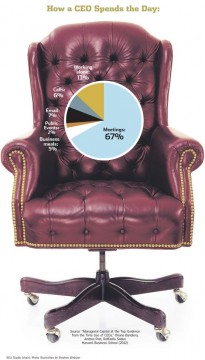Every business owner faces a time dilemma: is the best use of my time in the office, or outwardly focused? The pull of glory and “fun” and ego strokes can be powerful magnets to go represent your firm to “the marketplace.”
Perhaps we can get some insight from an MSNBC poll. According to that poll, 88% of MSNBC readers have “innie” navels and 8% have outies or somewhere in between. People will even undergo cosmetic surgery (!) to have an innie. While the above distributions reflect body types, perhaps navel types can shed some valuable light on business owner types!
Researchers have found that business owners who are what I call innies create firms with higher value. The message for business owners? It’s important to keep focus on what’s going on inside your company and not hit the ski slopes or the golf course too early or too often.
We can learn lessons about time use from management research. Henry Mintzberg did research for his Ph.D. thesis at MIT over 40 years ago. He discovered that this small population of CEOs spent over 80% of their work hours in meetings. (No surprise here).
More recent research primarily in India, with corroborating research on smaller samples of American and Irish executives, shows that even in a smartphone era, CEOs continue to spend the lion’s share of their time in meetings as illustrated below:

On the other hand, what builds the most value (multiples of EBITDA) for your company?
The answer, of course, is: it depends.
Harvard Business School professors Michael Porter and Nitin Nohria have done a time-use study of 354 Indian CEOs including those in attendance at CEO meetings.
Their research illuminated two predominant styles. Style 1 CEOs spend most of their time meeting with employees in a variety of settings from small groups to large ones. I’ll call these “innies.” Style 2 CEOs tend to spend their time alone, in one-to-one interactions and outside the firm. Let’s call them “outies.”
According to these researchers, the main role of a CEO is to optimize the firm itself: to run the company. Few entrepreneurs are geared that way. At some point, they need to hire someone who is more of a COO.
Porter and Nohria found that the innie CEOs had two primary skills that allowed them to create firms with higher value. They are masters at two-way communication. Like an expert shot putter, they know how to put their whole being behind these meetings.
First, they have an uncanny ability to tease out information from underlings to fuel effective decision-making. I recall being on the receiving end of such an encounter with a VP focus group. Since that firm had an unspoken rule “make the boss look good and don’t break rank” it was challenging to have the wisdom to know how to honor that while pointing to an obvious pile of dirty laundry.
Second, these CEOs communicate their message and with accurate and consistent delivery. Tony Hsieh, founder of Zappos, is very skilled at enfleshing the Zappos message: [a] “service company that just happens to sell shoes.” Unlike the kids’ game of Telephone, Zappos itself enfleshed Tony’s message accurately and effectively: they propelled employees and their happy customers toward their billion-dollar sales target two years earlier than planned. And Amazon paid a purported $1.2B for them in 2008. It takes the great persistence, consistency, and skill of a Tony Hsieh to keep two-way communication going to prevent message distortions from setting in.
Next week we’ll look at Style 2 leaders—the outies—with suggestions on how to adapt if you tend to be that kind of leader.
Toolkit:
Questions to sharpen your Style 1 skills:
- When am I getting distracted by being a “technician” (managing) vs. adding value to this department in my firm (leading)?
- Given the natural tendency of any direct report to “manage upwards” what questions do I need to ask to get the information I need to make good decisions?
- If my preferred approach is Style 1, what can I do to prepare my firm for a great COO? Consider hiring a coaching specialist to help you know what leadership questions to ask.



